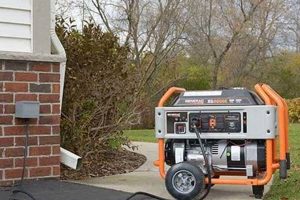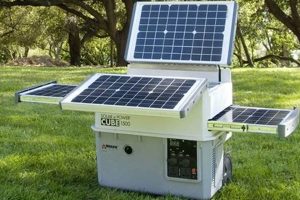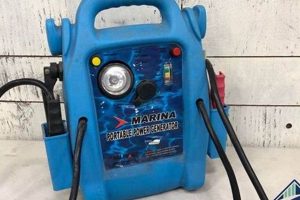Compact, fuel-powered electricity sources offer convenient power for tools at locations lacking standard electrical outlets. Construction sites, remote areas, and disaster relief efforts often rely on such devices for operation of saws, drills, and other essential equipment. Consider a construction crew framing a house in a newly developed subdivision without ready access to grid power, these units become critical for completing the project.
These independent power sources empower professionals and homeowners to work efficiently regardless of location. This independence has significantly impacted industries like construction, allowing for accelerated project timelines and increased productivity. Historically, reliance on grid power or cumbersome, less efficient generators limited work in remote locations. The evolution of smaller, more powerful, and fuel-efficient models has transformed these fields.
This article will delve deeper into the key considerations when selecting a suitable unit, including power output, fuel type, runtime, and noise levels. Furthermore, proper maintenance and safe operating procedures will be explored to ensure longevity and user safety.
Tips for Selecting and Using a Portable Power Source for Tools
Choosing and operating a suitable power source for tools requires careful consideration of several factors. These tips offer guidance for ensuring optimal performance, safety, and longevity.
Tip 1: Calculate Power Requirements: Determine the combined wattage of all tools intended for simultaneous use. The generator’s rated wattage must exceed this total to avoid overload.
Tip 2: Consider Fuel Type and Efficiency: Gasoline, propane, and inverter generators offer distinct advantages and disadvantages regarding runtime, fuel availability, and emissions. Evaluate which fuel type best suits individual needs and the environment.
Tip 3: Prioritize Safety Features: Look for features such as overload protection, low-oil shutdown, and ground fault circuit interrupters (GFCI) to minimize risks associated with electrical shock and equipment damage.
Tip 4: Evaluate Noise Levels: Noise levels can significantly impact the work environment. Consider quieter inverter models, especially for residential or noise-sensitive areas.
Tip 5: Ensure Proper Ventilation: Never operate a generator in enclosed or poorly ventilated spaces. Exhaust fumes contain carbon monoxide, a colorless, odorless, and potentially lethal gas.
Tip 6: Perform Regular Maintenance: Adhere to the manufacturer’s recommended maintenance schedule, including oil changes, air filter cleaning, and spark plug replacement. This ensures optimal performance and extends the lifespan of the equipment.
Tip 7: Store Fuel Safely: Store fuel in approved containers away from ignition sources and in a well-ventilated area. Never refuel a hot or running generator.
By following these guidelines, users can effectively leverage portable power sources to enhance productivity while ensuring safe and efficient operation.
This information provides a foundation for making informed decisions about portable power solutions for tools. Further research specific to individual needs and applications is recommended.
1. Power Output
Power output, measured in watts, represents a critical specification for portable generators intended for tool operation. This output determines the generator’s capacity to effectively power specific tools. An inadequate power supply can lead to tool malfunction, generator overload, and potential damage to both. Conversely, an excessively high output results in unnecessary fuel consumption and increased operational costs. A circular saw requiring 1500 watts, for example, necessitates a generator with a rated output exceeding this value. Attempting to operate the saw with a 1000-watt generator will likely result in insufficient power, causing the saw to stall or the generator to overload. A proper understanding of power output is crucial for efficient and safe tool operation.
The relationship between power output and tool requirements extends beyond individual tools to encompass the collective power demand of multiple tools operating simultaneously. Calculating the combined wattage of all intended tools is essential for accurate generator selection. Consider a scenario involving a drill requiring 500 watts, a work light at 100 watts, and a reciprocating saw at 700 watts. The generator must provide a minimum output of 1300 watts to power all three devices concurrently. Failing to account for the cumulative power draw can result in an overloaded generator and potential damage to equipment.
Effective power management requires matching generator output to specific tool demands, considering both individual and combined loads. This informed approach ensures optimal tool performance, prevents equipment damage, and promotes efficient fuel consumption. Careful consideration of power output during generator selection is paramount for successful and safe tool operation in various applications, from construction sites to home workshops.
2. Fuel Type
Fuel type significantly influences the practicality and effectiveness of portable generators for power tools. Common fuel options include gasoline, propane, and diesel, each presenting distinct advantages and disadvantages. Gasoline offers widespread availability and generally lower upfront generator costs. However, gasoline storage poses safety concerns due to flammability and potential degradation over time. Propane, stored in readily available tanks, burns cleaner and presents fewer storage hazards, though propane-powered generators can be less powerful than gasoline counterparts. Diesel offers superior fuel efficiency and extended runtime, often preferred for heavy-duty applications but necessitates higher initial generator investment.
The choice of fuel directly impacts the generator’s suitability for specific tasks. A contractor requiring continuous power for several hours might opt for a diesel generator, prioritizing runtime and fuel efficiency. A homeowner needing occasional power for small tools might choose a gasoline generator for its affordability and ease of refueling. A remote worksite prioritizing clean emissions might benefit from a propane-powered generator. Consider a disaster relief scenario: propane’s stability during storage makes it a valuable fuel source when gasoline availability might be compromised. Furthermore, environmental regulations increasingly favor propane and diesel for their reduced emissions compared to gasoline.
Understanding the nuances of each fuel type is crucial for maximizing generator performance and ensuring its suitability for intended applications. Careful consideration of fuel availability, storage requirements, cost, environmental impact, and runtime enables informed decision-making. Fuel type selection represents a pivotal factor in leveraging portable generator technology effectively and safely for powering tools in diverse contexts.
3. Runtime
Runtime represents a critical factor influencing the practical utility of portable generators for power tools. Defined as the duration a generator can operate continuously on a single fuel tank, runtime directly impacts productivity and operational efficiency. A longer runtime minimizes interruptions for refueling, crucial for time-sensitive tasks and remote locations where fuel resupply presents logistical challenges. Construction crews relying on generators to power saws, drills, and other equipment benefit significantly from extended runtimes, allowing uninterrupted project completion. Conversely, short runtimes necessitate frequent refueling, disrupting workflow and potentially impacting project timelines. Consider a remote construction project: a generator with a short runtime could significantly hinder progress, requiring frequent trips for fuel, while a long-runtime generator ensures continuous operation, maximizing efficiency.
Runtime considerations become particularly relevant when selecting generators for emergency preparedness or disaster relief. Extended power outages necessitate reliable power sources for essential appliances and tools. In such scenarios, a generator’s runtime dictates its ability to provide sustained power for critical needs like lighting, refrigeration, or medical equipment operation. A generator capable of running for eight hours offers significantly greater utility during an extended outage compared to a unit with a four-hour runtime. Furthermore, runtime influences the generator’s overall usability in recreational activities, such as camping or tailgating, where continuous power access enhances convenience and enjoyment.
Effective runtime assessment requires understanding the interplay between fuel tank capacity and fuel consumption rate. Generators with larger fuel tanks generally offer longer runtimes, but actual operational duration also depends on the generator’s load. Operating a generator at full capacity consumes fuel more rapidly, reducing runtime compared to operating under partial load. Therefore, accurate runtime estimations necessitate considering both tank capacity and anticipated power demands. Selecting a generator with appropriate runtime characteristics ensures uninterrupted tool operation, enhances productivity, and provides reliable power during emergencies, underscoring runtime’s crucial role in the practicality of portable generators for power tools.
4. Portability
Portability represents a defining characteristic of generators designed for powering tools, directly influencing their usability and suitability for various applications. The ease with which a generator can be transported and maneuvered significantly impacts its practicality in diverse environments, from construction sites and remote work locations to emergency preparedness scenarios and recreational activities. Evaluating portability involves considering factors such as weight, dimensions, and integrated features that facilitate transport.
- Weight and Dimensions
Physical attributes like weight and dimensions directly influence a generator’s portability. Lightweight, compact designs allow for easy transport by a single individual, while heavier, bulkier units may require mechanical assistance or multiple people for movement. Consider a contractor transporting a generator to a rooftop worksite: a lightweight model can be carried easily, while a heavier unit presents significant logistical challenges. Compact dimensions further enhance maneuverability in tight spaces, crucial for applications like indoor construction or disaster relief efforts within confined areas.
- Wheels and Handles
Integrated features such as wheels and handles significantly enhance a generator’s portability. Durable wheels, ideally designed for all-terrain mobility, facilitate transport across uneven surfaces common in construction sites or outdoor environments. Ergonomically designed handles provide secure grip points for lifting and maneuvering, reducing strain and enhancing user comfort during transport. A generator equipped with never-flat wheels and a telescoping handle navigates rough terrain more effectively than a unit lacking these features, highlighting the practical benefits of such design considerations.
- Folding Frames and Compact Storage
Folding frames and compact storage designs further contribute to portability, particularly for generators intended for occasional use or transport in vehicles with limited cargo space. Folding frames allow the generator to be collapsed into a smaller footprint, reducing storage requirements and enhancing transportability. Compact storage designs prioritize efficient space utilization, enabling users to stow the generator easily in vehicles or storage areas. These features benefit individuals who frequently transport generators for recreational activities like camping or tailgating.
- Impact on Application
Portability considerations ultimately dictate a generator’s suitability for various applications. A compact, lightweight generator proves ideal for powering tools at remote job sites accessible only on foot, while a larger, wheeled generator might be more appropriate for a construction site with vehicle access. In emergency preparedness scenarios, portability ensures individuals can quickly deploy the generator to power essential appliances. Consider a homeowner needing to power a sump pump during a flood: a portable generator can be moved easily to the basement, while a stationary unit lacks the necessary mobility.
By carefully evaluating these facets of portability, users can select generators that align with their specific needs and intended applications. The balance between power output, runtime, and portability ultimately determines the generator’s overall effectiveness and usability in powering tools across diverse environments, from professional construction sites to individual home use and emergency preparedness scenarios. A thorough understanding of portability considerations ensures that the chosen generator can be readily transported and deployed where and when needed, maximizing its practical value.
5. Noise Level
Noise level represents a critical consideration when selecting and operating a portable generator for power tools. Excessive noise can disrupt work environments, irritate neighbors, and potentially violate local noise ordinances. Understanding the factors influencing noise production and available mitigation strategies is essential for responsible generator operation.
- Decibel Levels and Human Perception
Generator noise is measured in decibels (dB). A typical conversation registers around 60 dB, while a portable generator can produce noise levels ranging from 60 to over 100 dB. Prolonged exposure to noise levels above 85 dB can cause hearing damage. A generator operating at 90 dB near a residential area can be significantly disruptive, highlighting the importance of considering noise output.
- Factors Affecting Noise Output
Several factors contribute to a generator’s noise output. Engine size and type, load, and enclosure design all play a role. Larger engines generally produce more noise than smaller engines. Operating a generator under heavy load increases noise compared to lighter loads. Generators with enclosed designs or mufflers tend to be quieter than open-frame models. Inverter generators, known for their variable engine speed, often produce lower noise levels than conventional generators, especially under lighter loads.
- Mitigation Strategies
Various strategies can mitigate generator noise. Placing the generator on a sound-absorbing surface, such as a rubber mat, can reduce noise transmission. Constructing a sound barrier around the generator using sound-dampening materials can further minimize noise propagation. Maintaining proper generator maintenance, including ensuring adequate lubrication and properly functioning mufflers, can also minimize noise output. Selecting a generator location away from work areas or residential buildings further reduces noise impact.
- Regulations and Considerations
Many communities have noise ordinances restricting permissible noise levels, particularly during certain hours. Operating a loud generator in violation of these ordinances can result in fines or other penalties. Choosing a quieter generator or implementing noise mitigation strategies demonstrates responsible operation and minimizes disruption to surrounding areas. In professional settings, providing hearing protection for workers operating near loud generators is crucial for safeguarding hearing health. Selecting generators designed for low-noise operation becomes especially important in noise-sensitive environments like hospitals or residential areas.
Careful consideration of noise level is essential for responsible generator operation. Understanding the factors influencing noise production and implementing appropriate mitigation strategies minimizes disruption, ensures compliance with regulations, and protects hearing health. Selecting a generator with low noise output is a key factor in achieving a balance between power provision and environmental responsibility. This consideration is crucial for various applications, from construction projects to emergency power supply and recreational activities.
6. Safety Features
Safe operation of portable generators for power tools requires careful attention to integrated safety features and adherence to safe operating procedures. These features protect users from potential hazards associated with electricity generation and fuel combustion, such as electric shock, fire, and carbon monoxide poisoning. Understanding and utilizing these safety mechanisms is crucial for mitigating risks and ensuring user well-being.
- Overload Protection
Overload protection prevents damage to the generator and connected tools by automatically shutting down the unit when the electrical load exceeds its rated capacity. This feature safeguards against overheating and potential fires caused by excessive current draw. For instance, attempting to operate multiple high-wattage tools simultaneously could overload the generator; the overload protection feature intervenes, preventing damage. This automatic shutdown mechanism is crucial for preventing equipment damage and ensuring user safety.
- Low-Oil Shutdown
Low-oil shutdown protects the generator’s engine from damage caused by insufficient lubrication. This feature automatically shuts down the engine when oil levels drop below a critical threshold, preventing costly repairs and extending the generator’s lifespan. Without this feature, continued operation with low oil could lead to engine seizure and premature failure. This automatic shutdown is essential for preserving the generator’s functionality and preventing costly repairs.
- Ground Fault Circuit Interrupter (GFCI)
GFCI protection safeguards users from electric shock. GFCI outlets detect imbalances in electrical current flow, indicating a potential ground fault, and rapidly interrupt the circuit, preventing dangerous shocks. In a scenario where a power tool’s insulation becomes damaged, a GFCI outlet would quickly cut off power, minimizing the risk of electrocution. This feature is particularly important in damp or wet environments, where the risk of electric shock is heightened.
- Carbon Monoxide (CO) Detectors/Shutoff
CO detectors and shutoff mechanisms address the hazard of carbon monoxide poisoning. These safety features monitor CO levels emitted by the generator’s exhaust. If CO levels reach dangerous thresholds, the generator automatically shuts down, preventing potential exposure to this odorless, colorless, and potentially lethal gas. In enclosed spaces or areas with poor ventilation, CO accumulation poses a serious threat. This automatic shutoff feature is critical for protecting users from CO poisoning.
These safety features, when combined with responsible operating practices such as proper ventilation and adherence to manufacturer guidelines, significantly enhance the safe operation of portable generators for power tools. Understanding and utilizing these safety mechanisms minimizes risks associated with electricity generation and fuel combustion, safeguarding users from potential harm. Careful attention to safety features contributes to a secure and productive work environment, whether on a construction site, in a home workshop, or during emergency power situations.
7. Maintenance
Regular maintenance is essential for ensuring the longevity, reliability, and safe operation of portable generators used to power tools. Neglecting routine maintenance can lead to decreased performance, premature failure, and potential safety hazards. A well-maintained generator provides consistent power for tools, minimizing downtime and maximizing productivity. Conversely, a poorly maintained generator can become unreliable, resulting in costly repairs and potential safety risks.
- Regular Oil Changes
Engine oil lubricates moving parts, reducing friction and wear. Regular oil changes, as specified in the manufacturer’s guidelines, are crucial for maintaining engine health and preventing premature failure. Using the correct oil type and viscosity is essential for optimal performance. For example, failing to change the oil regularly can lead to increased engine wear, reduced efficiency, and potential overheating.
- Air Filter Cleaning/Replacement
The air filter prevents dust and debris from entering the engine’s combustion chamber. A clogged air filter restricts airflow, reducing engine efficiency and potentially causing damage. Regular cleaning or replacement of the air filter ensures optimal airflow and combustion. Operating a generator in a dusty environment necessitates more frequent air filter maintenance. Ignoring air filter maintenance can lead to reduced power output, increased fuel consumption, and potential engine damage.
- Spark Plug Inspection/Replacement
Spark plugs ignite the fuel-air mixture in the engine’s combustion chamber. Worn or fouled spark plugs can cause misfires, reducing engine performance and increasing fuel consumption. Periodic inspection and replacement of spark plugs are necessary for maintaining efficient combustion. A malfunctioning spark plug can lead to difficulty starting the generator, rough running, and decreased power output.
- Fuel System Maintenance
Maintaining the fuel system involves keeping the fuel tank clean and free of debris, using fresh fuel, and periodically draining the fuel tank to prevent stale fuel buildup. Stale fuel can cause starting problems and damage to the carburetor. Regular fuel system maintenance ensures reliable starting and efficient operation. Using fuel stabilizer can help prevent fuel degradation during storage, particularly important for seasonal use.
Adhering to a regular maintenance schedule, as outlined in the generator’s owner’s manual, ensures reliable operation, prolongs the generator’s lifespan, and minimizes the risk of malfunctions and safety hazards. Proper maintenance contributes to efficient power delivery for tools, reducing downtime and maximizing productivity in various applications, from construction sites to emergency power supply. Ignoring maintenance requirements can lead to costly repairs, decreased performance, and potential safety risks, underscoring the crucial role of regular maintenance in maximizing the value and lifespan of portable generators for power tools.
Frequently Asked Questions
This section addresses common inquiries regarding the selection, operation, and maintenance of portable generators for power tools. Understanding these aspects is crucial for safe and effective power generation.
Question 1: How is the appropriate generator size determined for specific power tool requirements?
Generator size selection depends on the combined wattage of the tools intended for simultaneous use. Calculate the total wattage required and choose a generator with a slightly higher rated wattage to accommodate potential surges and future tool additions. Consulting a wattage calculator or electrician can provide further guidance.
Question 2: What are the key distinctions between conventional and inverter generators for power tool applications?
Conventional generators produce raw power, while inverter generators produce cleaner, more stable power suitable for sensitive electronics. Inverter generators are typically quieter and more fuel-efficient but often come at a higher price point. The choice depends on the specific power needs and budget.
Question 3: What safety precautions are essential when operating a portable generator?
Operating a generator in a well-ventilated area is paramount to prevent carbon monoxide buildup. Keeping the generator dry and away from flammable materials minimizes fire hazards. Proper grounding and avoiding overloading the generator are crucial electrical safety measures.
Question 4: What maintenance procedures are recommended for optimal generator performance and longevity?
Regular maintenance includes routine oil changes, air filter cleaning or replacement, and spark plug inspection. Following the manufacturer’s recommended maintenance schedule ensures optimal performance and extends the generator’s lifespan. Storing fuel properly and using fuel stabilizer prevent fuel-related issues.
Question 5: What environmental considerations are relevant when using a portable generator for power tools?
Generators produce emissions that can contribute to air pollution. Choosing a fuel-efficient model and adhering to recommended maintenance practices minimize environmental impact. Exploring alternative power sources, such as solar generators, offers a more sustainable option in certain situations.
Question 6: What factors influence the runtime of a portable generator?
Runtime is determined by the generator’s fuel tank capacity and the load applied to it. Operating the generator at full capacity consumes fuel more rapidly, reducing runtime. Fuel efficiency and external factors, such as ambient temperature, also influence the overall operational duration on a single fuel tank.
Understanding these frequently asked questions provides a foundation for safe and effective generator operation. Consulting the manufacturer’s documentation and seeking expert advice when needed further ensures responsible and informed generator usage for powering tools.
For further information, consult resources such as the Consumer Product Safety Commission and manufacturer websites.
Portable Generator for Power Tools
Careful consideration of factors like power output, fuel type, runtime, portability, noise level, safety features, and maintenance ensures appropriate generator selection and safe operation for powering tools. Matching generator capabilities to specific tool requirements is crucial for optimal performance and preventing equipment damage. Prioritizing safety features and adhering to safe operating practices minimizes risks associated with electricity generation and fuel combustion.
Investing in a portable generator represents an investment in reliable power access for tools, enhancing productivity in various settings. Informed decision-making and responsible generator operation contribute to efficient project completion and safe work environments. The evolution of portable generator technology empowers professionals and individuals with access to reliable power wherever needed, driving progress across industries and enhancing individual capabilities.






